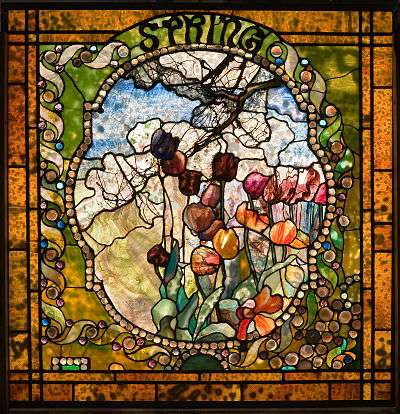Charles Hosmer Morse Museum of American Art
 | |
 Location within Florida | |
| Established | 1942 |
|---|---|
| Location |
445 North Park Avenue Winter Park, Florida |
| Coordinates | 28°36′03″N 81°21′05″W / 28.60086°N 81.35140°W |
| Type | Art |
| Website | Charles Hosmer Morse Museum of American Art |
The Charles Hosmer Morse Museum of American Art houses the most comprehensive collection of the works of Louis Comfort Tiffany found anywhere, a major collection of American art pottery, and fine collections of late-19th- and early-20th-century American paintings, graphics and the decorative arts. It is located in Winter Park, Florida, USA.
The museum was founded by Jeannette Genius McKean in 1942 and named for her grandfather.[1] She had long appreciated Tiffany's art during times when his reputation had faded from sight. It was originally named as The Morse Gallery of Art and located on the campus of Rollins College. In 1957, the McKeans learned from one of Tiffany's daughters that his estate, Laurelton Hall, had burned to a ruin. Jeannette McKean decided to rescue the Tiffany treasures, which were ready to be bulldozed with the debris from the fire. Her husband Hugh McKean,[2] who had been an art student at Tiffany's Laurelton Hall estate in 1930, remembered her exact words at the scene of the devastation: "Let's buy everything that is left and try to save it." Later Tiffany acquisitions included the parts of his 1893 chapel for the World's Columbian Exposition. The museum opened at its current location in 1995, and now has more than 19,000 square feet (1,800 m2) of public and exhibition space.
The Tiffany collection

The Tiffany collection forms the centerpiece of the Morse Museum. It includes examples in every medium he explored, in every kind of work he produced, and from every period of his life. Holdings range from a set of his famed leaded-glass windows down to glass buttons. It includes paintings and extensive examples of his pottery, as well as jewelry, enamels, mosaics, watercolors, lamps, furniture and examples of his Favrile blown glass.
The Tiffany collection includes the reconstructed Tiffany Chapel he created for the World's Columbian Exposition at Chicago in 1893, with its brilliantly colorful windows, mosaics, Byzantine-Romanesque architectural elements and furnishings. The chapel was fully reassembled and opened in April 1999 to the general public for the first time in more than 100 years. It is approximately 39 feet (12 m) long and 23 feet (7.0 m) wide, rising at its highest point to about 24 feet (7.3 m).
In February 2011, the Morse opened a new wing that provided for 6,000 square feet (560 m2) gallery space for the permanent exhibition of its collection of art and architectural objects from Tiffany’s Long Island country estate, Laurelton Hall.[3]
Other collections
_001.jpg)
Other leaded-glass windows in the collection include work by William Morris, Louis Sullivan, Frank Lloyd Wright, John LaFarge and Arthur J. Nash. Emile Gallé, René Lalique, and Peter Carl Fabergé are represented in the jewelry and silver. The furniture collection includes pieces by Emile Gallé, Louis Majorelle, and Gustav Stickley, as well as those by Tiffany. The museum also has over 800 pieces in its 19th-century American Art Pottery collection, including about 300 Rookwood pieces. The sculpture collection includes work by Thomas Crawford, Hiram Powers, Daniel Chester French, John Rogers, and others.
The museum also has a good collection of American paintings and prints. The paintings include work by Samuel F. B. Morse (a relative of Charles Hosmer Morse), Thomas Doughty, George Inness, John Singer Sargent, Rembrandt Peale, Cecilia Beaux, Martin Johnson Heade, Maxfield Parrish, Arthur B. Davies, Hermann Herzog, Thomas Hart Benton, and Samuel Colman. Prints include work by some of the same artists as well as Grant Wood, Mary Cassatt, Paul Cézanne, Childe Hassam, John Steuart Curry, and Edward Hopper.
References
- ↑ Jeannette Genius McKean
- ↑ http://www.morsemuseum.org/about/hugh_mckean.html
- ↑ "Morse Museum Expansion Recalls Grandeur of Louis Comfort Tiffany's Personal Estate" (PDF) (Press release). The Charles Hosmer Morse Museum of American Art. August 12, 2010. Retrieved January 21, 2016.
External links
| Wikimedia Commons has media related to Charles Hosmer Morse Museum of American Art. |
- Web site of The Charles Hosmer Morse Museum of American Art
- Louis Comfort Tiffany and Laurelton Hall: an artist's country estate, an exhibition catalog from The Metropolitan Museum of Art Libraries (fully available online as PDF), which contains material from the Charles Hosmer Morse Museum of American Art.
- "The Man Who Could Do Everything: Louis C. Tiffany at the Charles Hosmer Morse Museum" by Barrymore Laurence Scherer, The Magazine Antiques, July/August 2011. Review of the Tiffany galleries with image gallery.
- "Morse Museum's expansion makes it the place for Tiffany" by Matthew J. Palm, Orlando Sentinel, February 15, 2011. Article on the opening of the Tiffany wing.